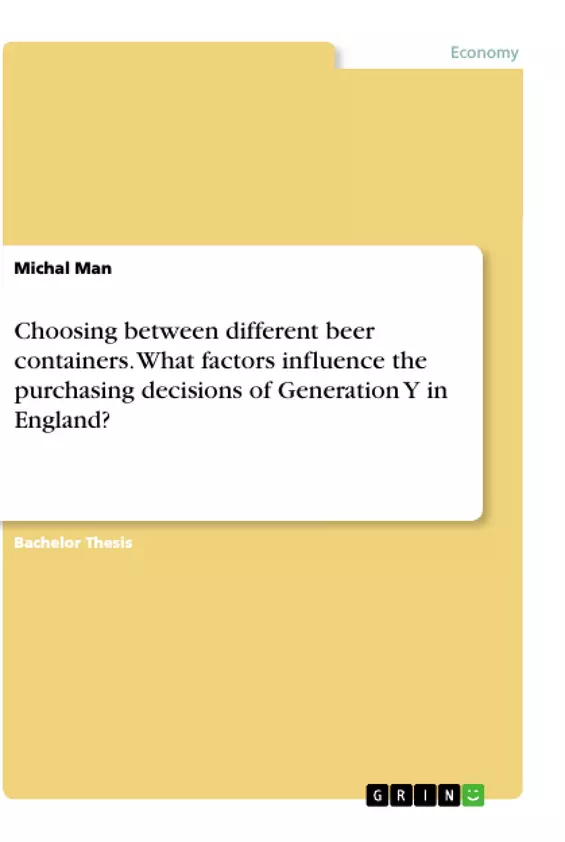This research is focused on the investigation of factors influencing purchasing decisions of Generation Y in England when choosing between different beer containers; specifically canned, bottled and draught beer products.
The objectives for this research were to review current and relevant literature on the beer industry, consumer behaviour and marketing sector in relation to beer purchasing by Generation Y in respect of different beer containers, to carry out primary research regarding the influencing factors of beer purchasing decisions of this segment, to analyse the research findings by offering discussion and evaluation of both primary and secondary data, and to present research conclusion including identification of limitations to this research and make recommendation for the beer market and further research.
In modern society beer is the leading drinks category in the UK by some distance in both volume and value sales. In this competitive market, product and packaging innovations are essential in order to create or maintain competitive advantage. Beer companies are introducing various fruit flavoured products and new package designs offering new ways to serve up a colder and smoother drink experience, and they have become adept at tapping into consumer insights to help direct such innovations. This research is focused on three major types of beer packaging and examines purchasing behaviour within the English youth market in the age banding 18-34; often referred to as Generation Y.
Inhaltsverzeichnis (Table of Contents)
- Introduction
- Academic Rationale for the Research Project
- Personal Rationale for the Research Project
- Aim and Objectives
- Dissertation Structure
- Chapter Conclusion
- Literature Review
- Beer Market
- Trends
- Prices
- Consumer Behaviour
- Consumer Decision Making
- Purchase Behaviour
- Brand loyalty
- Generation Y
- Advertising and Marketing Implications
- Beer Packaging
- Chapter Conclusion
- Methodology
- Introduction
- Importance of Research Studies
- Mixed-Methods Research
- Quantitative Research
- Strengths
- Limitations
- Online Surveys
- Qualitative Research
- Strengths
- Limitations
- Sampling
- Data Analysis
- Research limitations
- Time and Cost
- Limitations to Access
- Pilot Study
- Ethics
- Conclusion
- Research Findings and Analysis
- Introduction
- Sampling
- Age Samples
- Gender Samples
- Duration of Residency in England Samples
- Employment Status Samples
- Key Research Themes
- Price and Promotion
- Off-trade
- On-trade
- Taste
- Off-trade
- On-trade
- Material benefits
- Off-trade
- On-trade
- Brand loyalty
- Off-trade
- On-trade
- Occasion and Image
- Off-trade
- On-trade
- Value for money
- Off-trade
- On-trade
- Advertising
- Conclusion
Zielsetzung und Themenschwerpunkte (Objectives and Key Themes)
The research aims to explore factors influencing purchasing decisions of Generation Y in England when choosing between different beer containers, namely canned, bottled, and draught beer products. The research seeks to examine current literature on the beer industry, consumer behavior, and marketing related to beer purchases by Generation Y in respect to different containers, conduct primary research on influencing factors of beer purchasing decisions for this demographic, analyze research findings through a discussion and evaluation of both primary and secondary data, and finally, present research conclusions including limitations and recommendations for the beer market and future research.
- Consumer preferences of Generation Y in England regarding beer containers
- The influence of price, value for money, and taste on beer purchasing decisions
- The role of packaging, brand loyalty, and advertising in beer container choices
- Marketing strategies for different beer containers to appeal to Generation Y
- The impact of social and cultural factors on Generation Y's beer consumption habits
Zusammenfassung der Kapitel (Chapter Summaries)
The initial chapter outlines the academic and personal rationale for the research project, detailing its objectives, structure, and expected outcomes. It also presents a comprehensive overview of the beer industry, exploring trends, prices, and consumer behavior, specifically focusing on Generation Y, their purchasing habits, and brand loyalty. This is followed by an in-depth analysis of the chosen research methodology, highlighting the strengths and limitations of both quantitative and qualitative research methods, including online surveys and focus groups.
The research findings and analysis section delves into the data gathered through questionnaires and focus groups, examining key themes such as price and promotion, taste, material benefits, brand loyalty, occasion and image, and value for money in relation to different beer containers. This section provides a detailed exploration of the factors influencing Generation Y's purchasing decisions in both the off-trade and on-trade environments.
Schlüsselwörter (Keywords)
This research primarily focuses on consumer behavior, Generation Y, beer purchasing decisions, beer container preferences, marketing, advertising, price, value for money, taste, brand loyalty, and consumer segmentation. It investigates the influencing factors and explores potential strategies for effectively targeting Generation Y within the beer industry.
- Citar trabajo
- Michal Man (Autor), 2015, Choosing between different beer containers. What factors influence the purchasing decisions of Generation Y in England?, Múnich, GRIN Verlag, https://www.grin.com/document/518516



